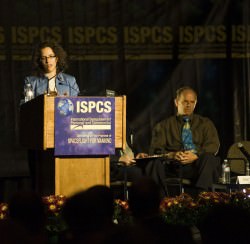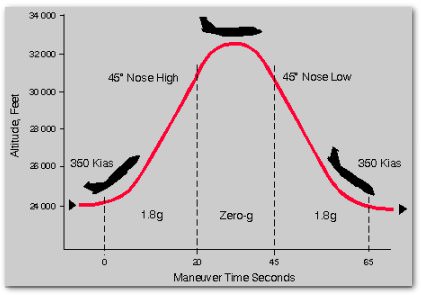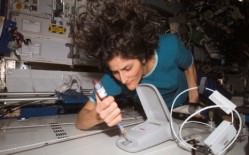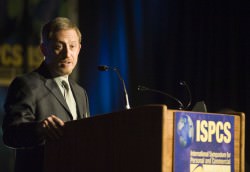Upcoming commercial space flights are no longer only about rich, adventure-seeking space tourists. Researchers hope to capitalize on the prospect of quick, low-cost and frequent access to the micro-gravity environment of sub-orbital space. “We’ve got these great vehicles coming online and most of the discussion about them so far have centered on the tourism market,” said Erika Wagner, member of SARG – the Suborbital Applications Researcher Group. “As researchers we felt this was a fantastic opportunity to do both science and education, as well.”
SARG was chartered by the Commercial Spaceflight Federation, and consists of around a dozen scientists and researchers from across the spectrum of the different sciences. Led by Alan Stern who formerly headed NASA’s science directorate, the group has sponsored three different workshops for scientists in Boston, Houston and Los Angeles, with another upcoming in Boulder Colorado (Feb. 18-20, 2010). “We want to inform researchers on this opportunity,” Wagner told Universe Today,” and find out how they want to use the vehicles and any constraints they might have, and feed that back to the vehicle designers and flight providers.”
About a year ago, SARG started surveying scientists, as well as getting the word out to NASA and other funding agencies that scientists were excited about sub-orbital space. “We’ve started to build some momentum now with the Commercial Reusable Suborbital Research program,” Wagner said, “and NASA has put up $2.6 million to support suborbital research in 2010. We’re putting everything in place to get everything structured to make this a viable research platform.”

Sub-orbital science appears to be a win-win situation for both scientists and the nascent commercial spaceflight companies. For researchers, the flights represent cheaper and more frequent access to space than anything NASA can provide with the space shuttle, parabolic flights or sounding rockets. For companies like Armadillo Aerospace, Blue Origin, Masten Space Systems, Virgin Galactic, and XCOR, adding science to their payloads represents the possibility of an additional $100 million a year in fares — roughly equivalent to the fares that would be paid out by 500 passengers.
Wagner said this new sub-orbital realm represents an entire new dimension for scientists. “The researchers hadn’t thought about it much before,” she said. “Mostly the research being done now is on the space shuttle and space station and is geared towards long duration flights. But the idea of how we use 3 or 4 minutes of microgravity is a real paradigm shift.”
“They would be able to do anything that requires being above the atmosphere but doesn’t require a Hubble Space Telescope,” Wagner continued,” or planetary science measurements, or atmospheric measurements as you go up and down. There’s a whole area that is called the “ignorosphere” – the part of the atmosphere that is too thin for planes to fly in but too thick for satellites to fly through, which has been pretty much ignored by the scientific community. But the suborbital vehicles go right through it.”
Then there’s basic fluids research- how do bubbles and fluids interact, which has implications for designing spacecraft engines –, particulates research, studying how the human body adapts to space, and other medical investigations.

“Several years ago researchers developed techniques for CPR in microgravity in case they ever need it on the space station,” Wagner said. “They tested in on the Vomit Comet, (parabolic flights) and you have only 20-30 second bursts, and it’s really hard to develop procedures for that, or especially for minor surgery or emergency procedures in that amount of time. 3-4 minutes gives you an opportunity to practice them and do training.”
Wagner, who works in life science research at MIT said what she finds most exciting is that sub-orbital opens up much more broadly the range of people that can be sent into space.
“Of the 450 or so astronauts that have been to space, all have been between 25-50 year of age, been very healthy and well trained,” she said. “Soon, there will be thousands of people who will be going into space which means we can begin to study the differences between men and women, young and old, and open it up to people who never would have been eligible to fly with NASA. Then we could study the effect of microgravity for someone who has a chronic heart condition or diabetes, or people who are on medication. For me that is the most interesting.”
A recent market analysis predicts there could be a demand for 13,000 passengers a year for commercial spaceflight, and SARG predicts there could be demand for over 1,000 flights a year for researchers.
“Down the line, we see 1,000 flights a year,” Wagner said.” Right now we have just a small handful of vehicle developers that have actual hardware in hand, and double that that are in earlier stages. Virgin Galactic is talking about one flight a day or several flights a day, so eventually we can see reaching that flight volume but it will be probably be several years.”

Early flights could include small payloads bolted to a rack or strapped down in the back of the vehicle, as well as passive data collection. “But once tourists start flying we can say, ‘Hey, would you mind if we took your blood pressure before the flight or would you be willing to wear an EKG harness?'” Wagner said, “– some easy things, which also might makes it more exciting for the tourists who can say they were part of an experiment on their flight.”
Later on, Wagner predicts researchers will be able to fly themselves to do hands-on science. “Does this mean that we are going to fly every scientist with his or her own payload or are there going to be a new class of payload specialists that emerge as commercial operators for science?” said Wagner. “It will be interesting to see how this develops.”
There’s plenty of potential for education, too. “Perhaps we can engage students in the work that is going on, and fly small payloads for students and actually allow them to get involved in science again,” Wagner said. “It’s been awhile since NASA has flown student payloads on the space shuttle, and these vehicles with higher flight frequency and lower costs are just custom made for getting students engaged. If commercial vehicles are flying every week, suddenly you can go end-to-end in a senior design project or have a master’s thesis where you’ve used the space environment for testing. Or you can design things that might fit in a tourist’s pocket, such as handheld sensors or iPhone apps and start to engage K-12 kids.”

Wagner and Stern recently spoke at a panel session at the International Symposium for Personal and Commercial Spaceflight in Las Cruces, N.M, where Wagner said the question she was asked most often was how suborbital science can contribute to the goal of humans living and working in space on a larger basis.
“For me it’s about opening the doors to the general population,” she said. “Right now if we were going to talk about sending people to Mars, it would be government astronauts — well selected, very fit, very healthy individuals. But if we are going to talk about a longer term vision of the future, where we open up that bottle and send the average Joe and Jane, now we can start to understand what might happen to you or I in space and what we need to do to support the general population – all ages, all genders, all nationalities, all health statutes. The opportunity to blow that wide open is really great.”
Source: Interview with Erika Wagner


How much carbon will the tourist joy ride part of this add to the atmosphere?
With the world economy faultering and the taxes on working people going up will there be enough elite left to take these trips?
With coventions in Las Vegas being portayed as wasteful and almost criminal how will these expensive short little trips to the edge of space be viewed by the poor? It might be hard sell to those who can’t afford bus fare to get to a minimum wage job.
We all need to conserve except the rich.
This is a new market and a new industry, so conservation doesn’t apply. That is what you can and will do with mature markets and techniques.
I’m not sure I understand the “economy faltering” part, as new markets helps the economy. And the rich-poor perspective is independent of the market, so that question is meaningless in a specific context.
Depends on the technique. Virgin will IIRC burn a rubber type material, but tries to go “green” – ideally you can make that from recyclable greens if you want. There are carbon free fuels as well.
The real problem is that aerosols and ozone scavenging chemicals will be added. But not enough to make a climate impact, at a guess.
“We all need to conserve except the rich”
That’s what Al Gore implied from when he made Global warming into his political campaign tool.
You really thought they would give up mega yachts and exotic vacations to stop some starving kid in Brazil from drowning?
Its just so they can make even more money by selling new light bulbs and windmills to the masses (or maybe you thought GE sells those goods at a premium price out of the charity of its heart?).
At least with suborbital and space development the rich are inadvertently paying for things that will benefit the rest of us. Its more like a super rich man paying to find a cure for cancer just so he doesn’t die from it.
To interrupt the constructive part of that process would be to the detriment of humanity.
Errr – yacht have, you know, sails.
And the point is to conserve without reducing the standard of living. How must traction would Gore have if he demanded we all live in earth pits and straw houses like a certain brand of hippie would?
Gore is a very talented politician and as anyone should know “politics is the art of the possible”.
Finally, it doesn’t really matter what Gore does – except of course that if I thought you were actually right, it’d set a bad example – conservation and decreased carbon emission is still the right thing to do.
But, yeah, my initial thought was “what’ll the emissions be”, too. I’d certainly like to see some numbers. And it’d be nice to see the corresponding numbers for the US/World carpool.
This amounts to a piloted sounding rocket. I am not sure this is the most effective way to conduct short probe experiments.
The business of space tourism is silly, and frankly almost destined to fail. The Spaceship-1 or X-1 craft might fly a number of time, and then CRASH and space tourism is in the same status as the post-Challenger or post-Columbian shuttle program.
LC
I share Crowell’s concern about the wisdom of this approach. Small probes can be easily launched into the ‘ignorosphere’. Check out, for example, the Black Brant rocket: http://en.wikipedia.org/wiki/Black_Brant_rocket .
I have this idea for a WMAP type of probe that selects a number of very small solid angles of view into the CMB. The intention is to get a sample of some of the fine grained anisotropy from some regions. So pop a probe into suborbital space with a Black-Brant. With decent gyroscopes it maintains a precise orientation for 5-10 minutes, gets the data and relays the data back to Earth. You can get a payload up a lot higher and clearer of atmopheric effects.
LC
LC, that sounds like an excellent idea for a low cost, suborbital mission(and pretty cool, to boot). Advances in electronics now make microsatellites and miniaturized detectors to become a reality. Nothing against commercial entrepreneurs, but hardware to explore this region of the exosphere already exists.